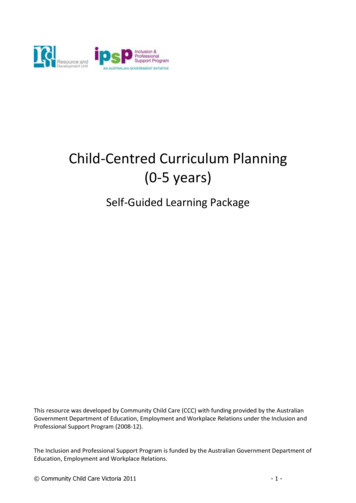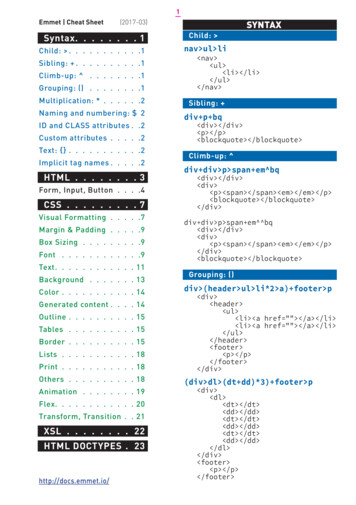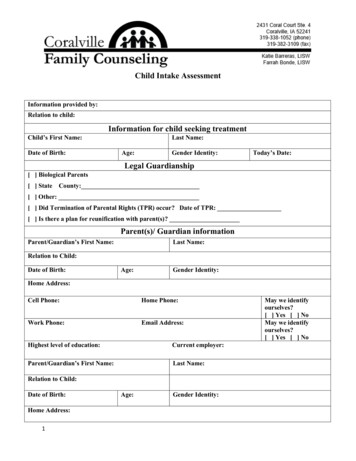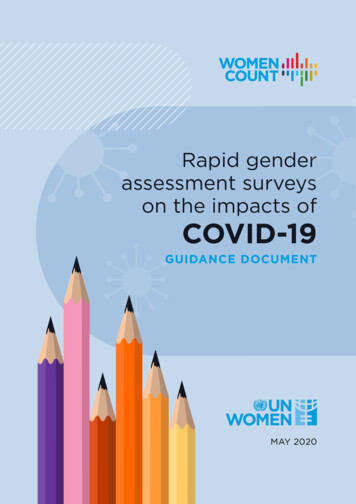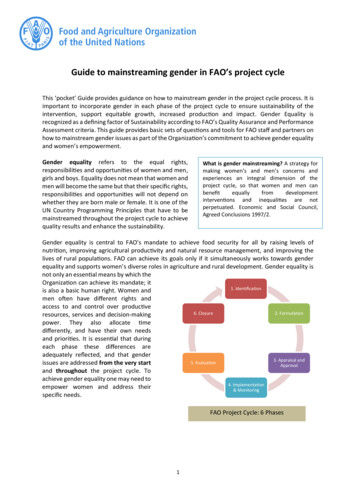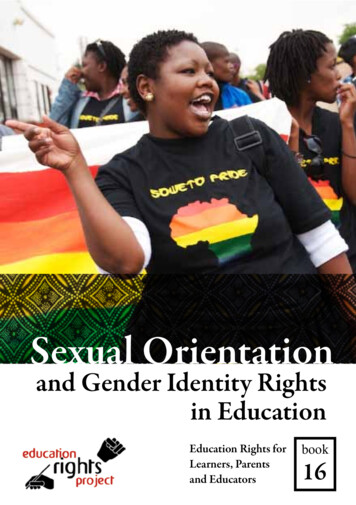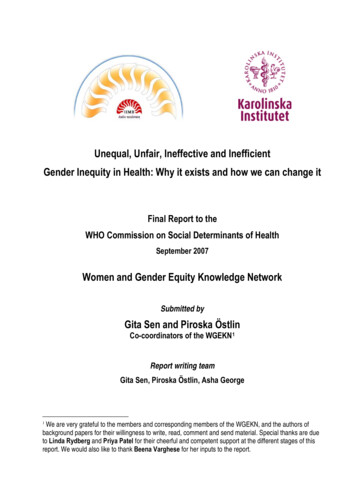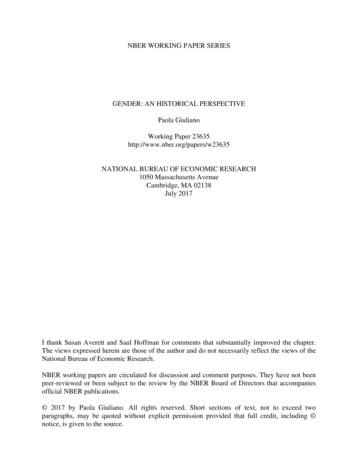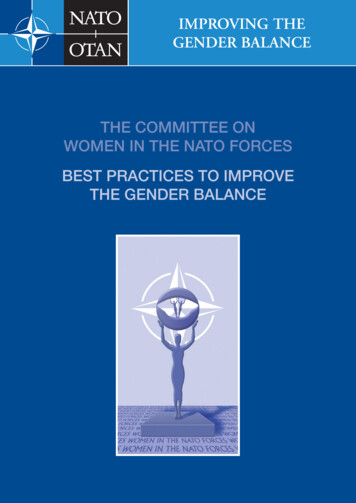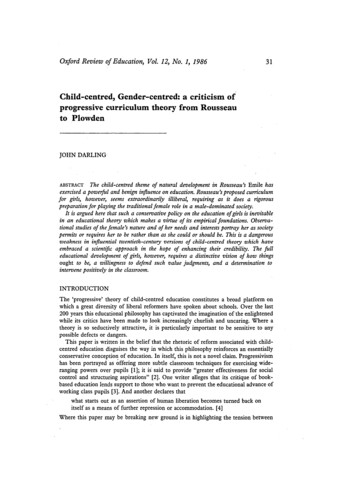
Transcription
Oxford Review of Education, Vol. 12, No. 1, 198631Child-centred, Gender-centred: a criticism ofprogressive curriculum theory from Rousseauto PlowdenJOHN DARLINGThe child-centred theme of natural development in Rousseau's Emile hasexercised a powerful and benign influence on education. Rousseau's proposed curriculumfor girls, however, seems extraordinarily illiberal, requiring as it does a rigorouspreparation for playing the traditional female role in a male-dominated society.It is argued here that such a conservative policy on the education of girls is inevitablein an educational theory which makes a virtue of its empirical foundations. Observational studies of the female's nature and of her needs and interests portray her as societypermits or requires her to be rather than as she could or should be. This is a dangerousweakness in influential twentieth-century versions of child-centred theory which haveembraced a scientific approach in the hope of enhancing their credibility. The fulleducational development of girls, however, requires a distinctive vision of how thingsought to be, a willingness to defend such value judgments, and a determination tointervene positively in the classroom.ABSTRACTINTRODUCTIONThe 'progressive' theory of child-centred education constitutes a broad platform onwhich a great diversity of liberal reformers have spoken about schools. Over the last200 years this educational philosophy has captivated the imagination of the enlightenedwhile its critics have been made to look increasingly churlish and uncaring. Where atheory is so seductively attractive, it is particularly important to be sensitive to anypossible defects or dangers.This paper is written in the belief that the rhetoric of reform associated with childcentred education disguises the way in which this philosophy reinforces an essentiallyconservative conception of education. In itself, this is not a novel claim. Progressivismhas been portrayed as offering more subtle classroom techniques for exercising wideranging powers over pupils [1]; it is said to provide "greater effectiveness for socialcontrol and structuring aspirations" [2]. One writer alleges that its critique of bookbased education lends support to those who want to prevent the educational advance ofworking class pupils [3]. And another declares thatwhat starts out as an assertion of human liberation becomes turned back onitself as a means of further repression or accommodation. [4]Where this paper may be breaking new ground is in highlighting the tension between
32Oxford Review of Educationthis kind of educational philosophy and the feminist objective of changing school andsociety along non-sexist lines. This point is important in its own right; but it is alsoimportant for the way it underlines the inherent conservatism of child-centrededucation, and because it shows how this is attributable to the nature of progressivism's theoretical basis.ROUSSEAU ON THE DETERMINANTS OF A GIRL'S CURRICULUMA prima facie case can be established by looking in the first instance at that greatsource of all child-centred writing, Rousseau's Emile. Froebel was inspired by thiswork, and A. S. Neill felt in hindsight that he had been unwittingly practising itsprinciples. Two modern classics of child-centred education, England's Plowden Reportand Scotland's Primary Memorandum, both bear witness to Rousseau's influence andcan be understood as attempts to cash out some of his principles in modern classroomterms.Among the principles governing Emile's curriculum are three which have beenespecially admired. First, Emile should have unlimited scope for play. This isadvocated partly on humanitarian grounds, and partly because of the learning potentialof such activity. Secondly, Emile is not to be pressurised into studying: learning will beacquired when the child develops the appropriate interests and capacities. Thirdly,Emile is not to be directly taught: instead he should be encouraged to think things outfor himself and to draw conclusions from his own experience.As well as giving this well-known account of the education of Emile, Rousseau'streatise also describes the ideal curriculum for a girl. (This programme is proposed foranother fictitious character called Sophie.) Rousseau's curriculum for girls has notbeen widely discussed, and it is symptomatic of our times that one writer has recentlytried to explain this in terms of sex bias. Historians of educational thought are declaredtohave neglected Sophie because they have implicitly defined their subjectmatter as the education of male human beings, rather than the education ofall human beings. [5]There are, however, other possible explanations for the neglect of Sophie's educationwhich are more plausible and less strained. Emile is a long book to study, and Sophiedoes not appear until the second half of the narrative. The account of her education ispedestrian compared with Rousseau's proposals for Emile: why should educationalistsspend time on the former when the latter offer stimulation and illumination? Finally,the principles of Sophie's education are too far out of tune with our thinking in the lastquarter of the twentieth century for them to be seen as relevant, assimilable or worthyof consideration. It is hoped, however, that this paper will show that Rousseau's viewson girls' education are significant and enlightening, though not in the way Rousseauintended.In Rousseau's account of Sophie's education all the principles outlined above arereversed. Sophie is to have little freedom [6]. Her play, says Rousseau, ought to befrequently interrupted so that she learns to put up with life's irritations. Instead oflearning being pursued in accordance with the learner's own pace and inclinations,Sophie's lack of application in arithmetic lessons is to be combated by rewarding goodwork with cherries [7]. Instead of exercising her own judgment on religious questions,she is to learn religious doctrines without going into the reasons for holding them [8].
Progressive Curriculum Theory 33Rousseau's underlying reason for this difference in strategy is that girls' educationcannot be the same as boys' education because girls are not the same as-boys. Inpositive terms Rousseau sees the female as more modest, more cunning, moreunderstanding of the opposite sex and more skilled in personal relationships. Thethings women lack are concentration, accuracy, moderation in both religious faith andsexual desire, skill in abstract disciplines and good judgment in literary matters.Rousseau's explanation of these differences between the sexes is that they arecomplementary and that male and female are intended to pool their native resources:Woman has more wit, man more genius;woman observes, man reasons; together theyprovide the clearest light and the profoundestknowledge which is possible to the unaided mind. [9]But this division of talents hardly suggests a partnership between equals, and Rousseauin fact maintains that the law of nature bids the woman obey the man. In proceduralterms it is significant that Emile's development is explained in its own terms whileSophie's nature is explained in terms of how it differs from Emile's.Perhaps the most important difference in his curricular proposals for girls and boysis that while Rousseau explicitly rules out the preparation of boys for any specificfuture role, a girl's education is to be conducted in the light of the destiny which hernature determines. Men, he says, are only sometimes men, but women are alwayswomen [10]. Females should play the role of compliant wife, mother and home-maker,and girls should be educated with this future in mind.Why does Rousseau believe in the importance and Tightness of the woman'straditional role? In the first place he suggests that it has always been like this. Thetraditional role is more generally accepted the further back you go in history; and, forRousseau, earlier times were closer to a state of nature and therefore morally superior.Further, the nature of the sex act shows that the male is intended to dominate and thefemale is meant to please. Physiologically, the female is made for child-care; herdomestic role is essential for the prospering of family life; and any subsequent changeof role is supposedly injurious to her health. Finally, a woman will not flourish in maleoccupations ("a woman is worth less as a man") [11]; so she should stick to what sheexcels in instead of rebelling against nature's intentions.These intentions are manifest at an early age; every young girl actually likes sewing,says Rousseau, and loves playing with dolls. This, he concludes, "shows her instinctivebent towards her life's work" [12]. Today we might be able to think of alternativeexplanations for these interests. It is certainly curious that while in other contextsRousseau is very much alive to the power of environmental influence and thelikelihood of children acquiring ideas which are prevalent in society, his explanation ofgirls' interest in sewing is given in terms of instinct and a 'grand design'.The design of nature means that the future role of every girl is laid down in advance.This role determines what every female needs—essentially, male admiration andrespect. This need in turn dictates the curriculum for girls. "They should learn manythings, but only such things as are appropriate" [13]. These include learning to bepleasing, learning to submit to male authority and acquiring useful accomplishments.One such accomplishment is the art of conversing agreeably with their husbands: forthis girls require an education that transcends the more menial domestic arts. Theymay, for example, be introduced to logic and metaphysics but they "should only skimthe surface" [14]. A girl's curriculum must from start to finish be designed for the
34Oxford Review of Educationbenefit of men; but since women need men's good-will, this kind of instruction willalso be to the benefit of the female pupils.Rousseau's views on the nature of girls' education are directly related to his views onthe proper place of women: indeed he treats the two questions as a single issue. We cantell that his stance here is conservative even by the standards of his times; first,because he presents it as a call to return to the ways of nature; and secondly because hecriticises contemporary loss of respect for the traditional sexual division of labour. Hecomplains that men are working in shops and in the tailoring trade while women setthemselves up as literary critics. Before the eighteenth century was out, Rousseau wasbeing powerfully castigated by Mary Wollstonecraft on behalf of 50% of the population [15].How did the founder of progressive educational theory come to propagate such aview of females and their education? It is tempting to try to excuse this as anidiosyncratic aberration explicable in terms of Rousseau's troubled experiences withthe opposite sex. Like most men, he found difficulty in getting his women to be exactlyas he wanted them to be. Unlike most, however, he seems to have been unable to cometo terms with this. It may be that writing Emile was his response: a fantasy curriculumwas designed which would produce women in an unblemished form, prepared to playtheir proper role.Instead of this easy, dismissive interpretation, however, it seems more fruitful to tryto see why the kind of liberal educational philosophy for which Rousseau is justlyreputed could accommodate or even entail such an impoverished curriculum for girls.His unabashed espousal of what we now call 'sexism' provides a conveniently dramaticprompt for the question: Is there something in child-centred education which lendssupport to such a conservative position and which obstructs the development of moreradical views? To explore this question effectively we must move beyond Rousseau tomore modern, and widely accepted, statements of child-centred thinking.THE APPEAL TO SCIENCEThe essence of the child-centred critique of traditional schooling is that its methodsare 'ill-matched to' or 'not in harmony with' the nature of those whom it purports toeducate. So progressive writers from Rousseau onwards have spent much time andspace explaining to readers what children are really like, how they develop, and howthey learn.The picture of the child presented in typical child-centred writing is one of a naturallearner who is keen to find things out and anxious to make sense of his world. Theobjection that this view is at odds with the experience of many teachers is brilliantlydeflected in a way that confirms the progressive's perception of both child and school.Pupils may in practice seem reluctant to learn, but this, it is argued, is due to theiroriginal disposition being thwarted and perverted by a repressive and unintelligentprocess of schooling. The devastation caused by educational traditionalism can bedemonstrated by observing that five-year-olds enter school keen, interested, eager tolearn and noting that after 15,000 hours of schooling they emerge cynical andindifferent. This loss of interest is seen not as a natural development, but as somethingpathological which requires diagnosis.One important part of the answer has been to say that while each child is aninstinctive researcher, the form that his enquiries would naturally take bears littleresemblance to the subject-based divisions of knowledge that make up the traditional
Progressive Curriculum Theory 35curriculum. To replace this the child-centred educationist advocates a curriculumwhich is based on the child's needs and interests, and which takes proper account ofthe nature of the child and the way he develops. Hence the Plowden Report's famousdeclaration:At the heart of the educational process lies the child. No advances inpolicy. have their desired effect unless they are in harmony with thenature of the child, unless they are fundamentally acceptable to him. [16]But what is the nature of a child, or indeed the nature
ABSTRACT The child-centred theme of natural development in Rousseau's Emile has exercised a powerful and benign influence on education. Rousseau's proposed curriculum for girls, however, seems extraordinarily illiberal, requiring as it does a rigorous preparation for playing the traditional female role in a male-dominated society. It is argued here that such a conservative policy on the .
